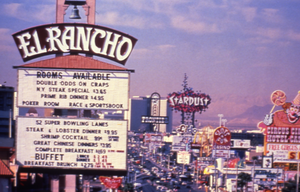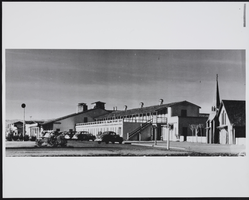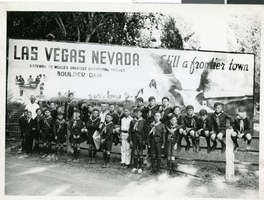Search the Special Collections and Archives Portal
Search Results
Buford, Eugene
Eugene Buford came to Las Vegas, Nevada from Birmingham, Alabama, when he was two years old with his mother and grandmother. He held a variety of jobs, including washing dishes at the Last Frontier and delivering ice to casinos like the Flamingo and the Stardust, and ultimately retired after thirty-six years with the Post Office. Buford's great grandmother, Mary Nettles, was instrumental in the formation and growth of the NAACP chapter in Las Vegas, and he recalls meetings in her house and his own role as president of the Junior League NAACP.
Person
Preciado, Mirna
Mirna Preciado was born July 21, 1956 and raised in Tijuana, Mexico. When her family decided to immigrate in 1980, she decided to reach for her American dream. Preciado’s husband wanted her to be a stay-at-home mom, but the idea of working and buying her own bread intrigued her. She became a waitress at the new Margarita’s Restaurant in the Frontier Hotel. Though she liked her work, she was bothered by the other workers with requests to join the Culinary Union Local 226. Soon, those workers became her guardian angels.
Person

Transcript of interview with Betty Ham Dokter by Roger Jablonski, February 27, 1977
Date
Archival Collection
Description
On February 27, 1977, Roger Jablonski interviewed Betty Ham Dokter (born 1922 in Las Vegas, Nevada) about her life in Southern Nevada. Dokter first talks about her upbringing and education in Las Vegas before describing church activity and the first casino properties that were built. She later talks about presidential visits, economic changes in Nevada, the construction of Hoover Dam, and some of the social changes in Las Vegas. The latter part of the interview covers the topics of racial minorities, environmental changes, early grocery stores and movie theaters, and social clubs. The interview concludes with a brief discussion on Mt. Charleston.
Text

Transcript of interview with Mary Habbart by Jane Finfrock, February 28, 1979
Date
Archival Collection
Description
On February 28, 1979, Jane Finfrock interviewed Mary Habbart (born 1897 in Boothwyn, Pennsylvania) about her life in Southern Nevada. Habbart first talks about her move to Las Vegas in 1920 and her husband’s subsequent employment. She also talks about the first casinos, the development of the university campus, visits of U.S. presidents, and the Mormon Fort. She also discusses the Helldorado Parade, flash floods, snowing in Las Vegas, her role in developing Sunset Park, her family, and her education.
Text

Myron E. Leavitt interview, March 14, 1978: transcript
Date
Archival Collection
Description
On March 14, 1978, collector Thomas Neill interviewed Myron E. Leavitt (born October 27th, 1930 in Las Vegas, Nevada) at his law office in Las Vegas, Nevada. In this interview, Leavitt discusses his law practice and running for various positions in Las Vegas, Nevada. He also speaks about growing up, playing sports, and coaching multiple sports in Las Vegas.
Text

Interview with Donna Smith, November 4, 2006
Date
Archival Collection
Description
Text

Slide of the El Rancho marquee and neon signs on Las Vegas Boulevard, Las Vegas, Nevada, 1986
Date
Archival Collection
Description
Image

The Little Chapel of the West: photographic print
Date
Archival Collection
Description
Image

Photograph of boy scouts in front of a sign, Las Vegas, 1929.
Date
Archival Collection
Description
Image

Photograph of the Desert Love Buggy in the Helldorado parade, Las Vegas (Nev.), 1934-1950
Date
Archival Collection
Description
Image
